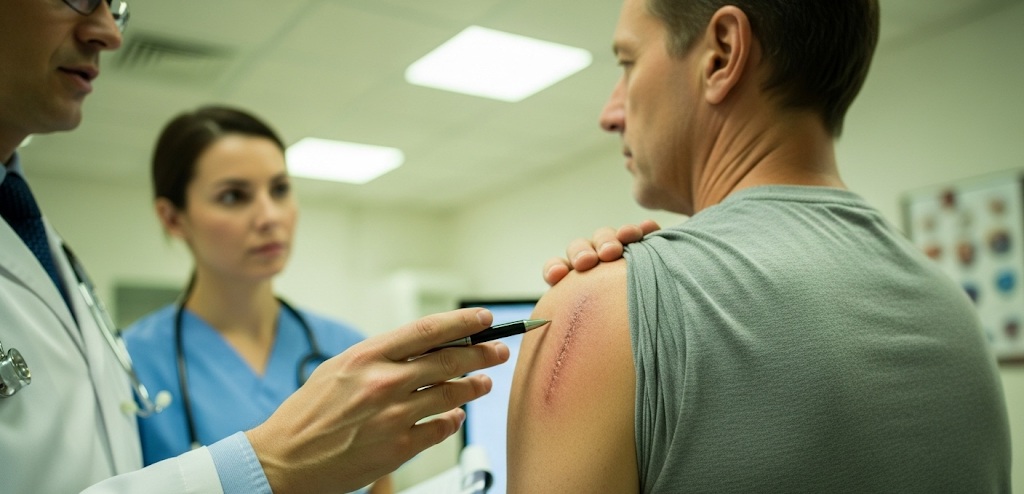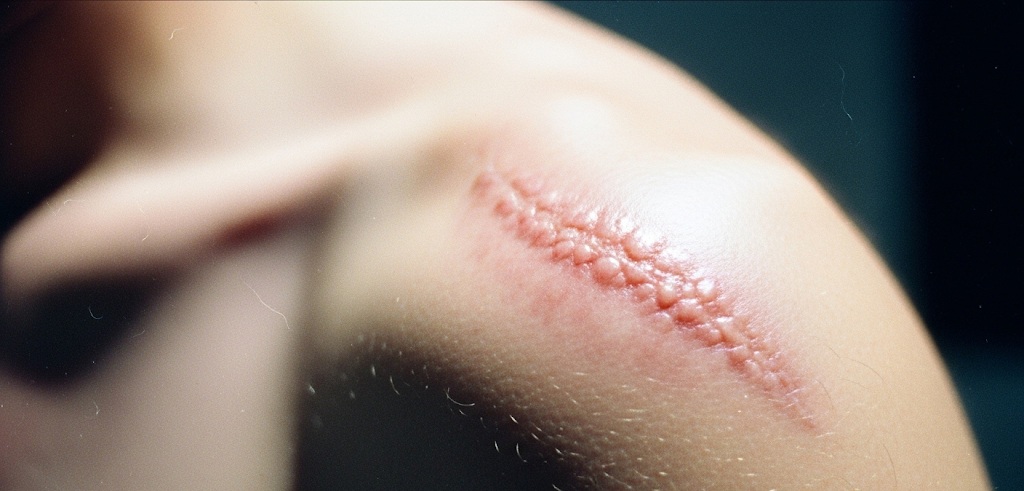Of all the things that come with healing after surgery, injury, and even acne, scar discoloration is one of the trickiest. That’s because it depends on many factors: your skin tone, your age, your health history, and the part of the body we are talking about.
How do we prevent scar discoloration? Yes, sunblock, serums, and vitamin E sometimes help. But with surgical scars, we usually go further with skin regeneration treatments.
I’m a board-certified cosmetic surgeon, so I really focus on scar planning during procedures and on aftercare. It takes the right approach to dermatology so we can prevent dark spots, pigmentation changes, and uneven skin tone.
In this article, we’ll cover everything you need to know about scar discoloration: Why they turn red, purple or brown, how different skin tones can affect, and the best treatments to heal well. So let’s dive in.
What Is Scar Discoloration?
Most scars start out red or pink. It happens because of increased blood flow and inflammation during healing. Over time, some scars fade back to your natural skin tone. Others may darken, lighten, turn brown or even purple.
Scar discoloration simply means a change in skin tone after a wound heals. It’s part of the natural process, but what usually concerns people about it is the final color. Will it go back to normal, will it vary?
To understand scar discoloration we need to talk about pigmentation. This refers to your skin’s natural color, which is controlled by melanin, that’s the pigment that gives color to your skin, hair, and eyes.
When a scar heals lighter than the surrounding skin, that’s called hypopigmentation. It means there’s been a loss or disruption of melanin.
On the other hand, when scars turn darker, we call it hyperpigmentation. This happens when the skin produces extra melanin in response to trauma. Hyperpigmentation is especially common in deeper wounds, darker skin tones, or scars that were exposed to the sun while healing.
Let’s now have a quick overview of the scar healing process, and its colors.
The 3 Stages of Scar Healing
- Hemostasis & Inflammation: Right after the skin is injured, it usually turns pink or red. The area swells and turns red as more blood flows in, carrying oxygen, nutrients, and immune cells to start the healing process.
- Proliferation: During the first week or so the fibroblasts start acting. These cells are responsible for making collagen, and they lay down a new mesh of tissue. At this stage, the wound begins to fill in and strengthen, and it may darken.
- Remodeling: This final stage is when the scar matures, and may fade or keep its color. This can take from 3 months to sometimes to a whole year. Collagen becomes denser and more organized, while elastin is reduced. That’s why scars often feel firmer and less flexible than normal skin.
Types of Scar Discoloration
To summarize things, when we talk about scar discoloration, these are the main types we see:
- Red or pink scars: These are fresh scars. The tissue is new, blood flow is high, and healing is just getting started.
- Brown or dark scars: Known as hyperpigmented scars, this happens when the skin produces extra melanin in the injured area, making it darker than the surrounding skin.
- White scars: These are hypopigmented scars, which occur when there’s a loss of melanin. They’re less common and tend to be less noticeable in lighter skin tones.
- Keloid and hypertrophic scars: These are raised scars that often look darker and feel thicker than the skin around them. They can grow larger than the original wound, which is why prevention and early treatment are key.
Each type of discoloration tells us something about how the scar is healing. Is it fading as we want? Does it look larger?
All that guides us toward the right treatment approach.
Causes of Scar Discoloration
So why does scar discoloration happen? A lot comes down to how the skin heals. During recovery, your body is busy balancing melanin activity, blood flow, and collagen production. If any of these shift too much, the scar can end up darker, lighter, or more raised than the surrounding skin.
As we mentioned earlier, the location of the scar also matters. Areas with strong circulation, like the face or chest, tend to heal more evenly. Spots with weaker blood flow, like the legs, often struggle to get enough oxygen and nutrients, which can slow healing and affect color.
Then, a really important thing is the patient’s skin tone. People with darker complexions are more prone to keloids or hypertrophic scars, where the tissue grows beyond the original wound.
If you’ve ever had a piercing or a scratch that turned into a thick, spreading scar, you might be keloid-prone, that’s something worth mentioning before surgery, or scar managing treatment.
And then there’s age. Many assume younger skin always heals better, but it’s not that simple. Kids and teens heal quickly, but their scars can react aggressively and become raised.
In fact, as Science Daily research points out, older skin tends to be thinner and have less chances to form thick, raised scars. So even though aging slows down the body’s healing process, some scars may still respond to treatments that help rebalance collagen and pigmentation.
Home Remedies for Scar Healing
Let me begin with the first rule of scar care: keep the wound moist, just use gentle cleaning with soap and water.
Also, something I recommend to all my patients right after surgery: plain vaseline. helps your skin stay protected while it starts the healing process.
Before we talk about other natural remedies for scar discoloration work, let’s bust a few common myths. These popular “solutions” can actually slow things down:
- Hydrogen peroxide and alcohol: Harsh on healing tissue, they delay recovery instead of helping.
- Vitamin E oil: Despite the hype, it doesn’t speed healing and can actually cause irritation or allergies. As studies show, the problem with this is its concentration. Eating Vitamin E food it’s fine.
- Antimicrobial soaps: Too drying and disruptive to the skin barrier.
- Iodine: Toxic to fibroblasts, the very cells your body uses to build new tissue.
Now, once your scar is past that initial healing stage, there are two key things I always recommend for better results:
Silicone Gel and Tape
Silicone is one of the most widely tested and effective options for scar healing. It helps scars look flatter, softer, and less red. It’s safe, and also simple to use:
Just apply a thin layer of silicone gel (no need to glob it on) or use silicone tape. Both work well, so it just depends on where your scar is and what feels most comfortable for you.
The only important thing about this is to always check that the product is 100% silicone for the best results.
Sunscreen
Yes, good old sunscreen. Fresh scars are extra sensitive to sunlight. UV rays can damage collagen, darken scars, and slow down the healing process.
I recommend to my patients to go for a broad-spectrum SPF 50. While it only blocks slightly more UVB rays than SPF 30, every bit counts when protecting a healing scar. Just remember to reapply every two hours, especially if you’re outside or sweating.
Professional Scar Treatments

For discoloration itself, there are plenty of targeted options. Vascular lasers or IPL can help fade red scars. Topical agents and chemical peels are often used for darker, hyperpigmented scars.
For pale scars, excimer laser or light therapies may encourage pigment to return.
What else can we add to these specialized scar treatments?
Corticosteroid Injections for Hypertrophic Scars and Keloids
For patients dealing with keloids or hypertrophic scars, corticosteroid injections can be a useful option. These injections help calm inflammation, reduce excess collagen buildup, and flatten the scar.
Still, this is important to note: Corticosteroid injections are a focused treatment for severe, pathological scars like Keloids. And it’s often an ongoing treatment, since they can return once injections stop.
So while not my first choice for scar discoloration treatments, they’re sometimes the most effective path forward.
Laser Therapy for Scar Discoloration
Laser is one of the most popular treatments for scar discoloration, especially when scars are large, dark, or uneven. It works creating controlled micro-damage that stimulates new collagen production and resets melanin distribution. The result is a more even skin tone and smoother texture.
Most of my liposuction patients don’t even need this treatment. Still, laser is a standard today and as we’ll see, when combined with regenerative treatments it has even more potential.
Microneedling for Scar Treatment
Microneedling works by creating tiny, controlled micro-injuries that stimulate skin regeneration. At True Contour, I use Morpheus8, a technology that combines microneedling with radiofrequency energy to boost both collagen and elastin production deep in the skin.
Regenerative Medicine for Scar Discoloration
I saved the two best treatments for scar discoloration — microneedling and laser — for last, and for good reason. They key in our approach to regenerative medicine for the cutting-edge treatments I’d like to share next.
Stem Cells for Healing Scar Tissue
Stem cell therapy is one of the most researched approaches in cosmetic and regenerative medicine. Stem cells are “master cells” that have the ability to transform into different tissue types, which makes them especially valuable for scar repair. They support new, healthier skin growth, so scars really blend in with your natural skin tone.
For scar discoloration, stem cells may help restore melanin regulation while also improving collagen and elastin balance. Clinically, I’ve seen impressive results, especially when combining stem cells with microneedling. Think of it as giving the skin the building blocks it needs to rebuild itself.
In body sculpting, we can even source stem cells from your own fat through liposuction. This is how we turn one procedure into an opportunity for both contouring and scar repair.
How PRP Can Improve Scar Resurfacing
Another powerful tool in scar management is PRP, or platelet-rich plasma. It comes from your own blood: We take a small sample, spin it, and pull out the layer that’s rich in growth factors.
What’s the science behind that? PRP stimulates collagen and helps skin repair itself. But it really makes a difference when combined with CO₂ laser. The laser breaks down scar tissue and creates tiny channels in the skin. Then we apply PRP right away, so it sinks deep where it’s needed most.
Together, they soften scars, calm redness, and help the color blend closer to your natural skin tone. Session by session, patients notice their scars look flatter, smoother, and less noticeable.
Choosing the Right Clinic for Scar Treatment
By now you know the basics: clean with soap and water, protect with Vaseline, then add silicone and sunscreen. You’ve also seen the advanced options: microneedling, laser, stem cells, and PRP.
These are some of the best treatments for scar discoloration today.
Now the real question is who’s guiding your healing. At True Contour, we personalize scar care for every patient. Your skin tone, your procedure, your recovery. With more than 2,000 body sculpting procedures behind us, we know how to keep scars as smooth and natural as possible.
Many patients come to see us in Scottsdale, and others join us through video consultations. They ask the same questions you may have: How do I prevent scar discoloration? What will my scar look like long-term?
We take the time to answer and offer real solutions. No judgment, we just help their skin heal flat, smooth, and close to your natural tone. So if a scar is bothering you, let’s talk about it. Schedule a consultation with us today, and take the next step toward better healing.
